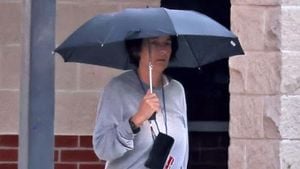With the 2024 California General Election looming on November 5, the dynamics are shifting, particularly as over 2 million voters have already cast their ballots early or via mail. This election isn’t just about choosing leaders; voters will also weigh in on ten statewide propositions covering pressing issues like crime, climate change, and housing. California’s voting climate reflects broader national sentiments and showcases the state's diverse demographics.
Recent data from Political Data Inc. indicates around 11% of registered voters have returned ballots compared to 2020 numbers. With approximately 22 million registered voters, there are nearly equal splits among political affiliations: about 5 million registered as Republicans and 10 million as Democrats, along with 4.8 million with no party affiliation. The higher turnout among Republicans—16.5% compared to Democrats’ 15.4%—marks a notable shift, especially considering the skepticism toward mail-in voting within the GOP.
This year, the party seems to have turned the corner. The California Republican Party, under the leadership of Jessica Millan Patterson, has embraced mail-in voting, recognizing not just its permanence since 2021 but also its potential as a viable strategy to increase voter turnout. Patterson stated, “I made it my mission to play by the rules the California Democratic Party has made and embrace early voting and ballot harvesting, and those efforts have paid off.”
Meanwhile, the demographic shifts within California's voter base are stark, with women, particularly from marginalized communities, being key players heading to the polls. A recent study from the University of Southern California's Center for Inclusive Democracy highlighted the correlation between increasing voter turnout among Black, Latino, and Asian-American voters and Democratic gains or losses at the congressional level. For example, many eligible voters from these communities did not participate last election, highlighting the potential for their influence this November.
The atmosphere surrounding the 2024 election reveals the ever-complex relationship between racial demographics and the political arena. For the first time, a Latino candidate is vying to represent the historically Black heartland of Los Angeles. Sade Elhawary, who identifies as biracial and has experience as both a teacher and community organizer, aims to unite Black and Latino communities as she contests for the 57th Assembly District. Her opponent, Efren Martinez, also seeks to engage both demographics amid rising concerns over representation and political equity.
With over 71% of the district’s residents being Latino and only 17% Black, the results of this election could signify changing political tides. The neighborhood, which produced California's first African American state legislators, is poised for possible transformation. Elhawary's resonance among voters stems from her determination to establish solidarity between communities, stating, “If people learn about my path, they’ll vote for us every time.” Building bridges through representation has been her mantra, positioning her as the voice of unity.
Another element shaping California's 2024 election concerns the ten propositions voters will decide on. Among them is Proposition 2, which plans to allocate $10 billion for public school construction and repairs. Proponents include several educational unions, but it faces opposition from taxpayer groups who are wary of increasing state borrowing.
Also noteworthy is Proposition 3, which addresses the ban on same-sex marriage from the California Constitution. This proposition seeks to reaffirm marriage equality, gaining traction with significant backing from the Democratic Party and advocacy groups, including Planned Parenthood.
Climate change also features prominently on the ballot with Proposition 4, which proposes funding for drinking water systems and disaster preparedness, showcasing California's commitment to sustainability amid increasingly dire environmental challenges.
Fed up with the rising costs of living, Proposition 5 seeks to lower the voting threshold for local governments to fund affordable housing projects, hoping to alleviate the housing crisis affecting millions across the state.
Yet it’s not all straightforward. The voter base is diverse, and the interplay of racial dynamics is palpable. Despite the push for unity, tensions linger. A recent scandal involving leaked audio from members of the L.A. City Council highlighted racial sentiments and the struggle for power between Latino and Black communities. This incident has somewhat overshadowed the hopeful efforts of candidates like Elhawary, emphasizing the grueling yet necessary task of fostering genuine coalitions.
Both candidates are actively courting voters through community engagement, addressing core issues such as housing, unemployment, and crime—societal concerns often at the forefront of residents' minds. Martinez, for example, is making targeted outreach by visiting Black churches, emphasizing faith-based solidarity.
Alongside these legislative races, County Officials are dealing with the mechanics of polling and voting—with reports indicating occasional hiccups, such as printing errors on mail ballots, which though not impactful on the counting accuracy will likely delay results. Meanwhile, as California prepares for what is anticipated to be another divisive election season, candidates and voters alike focus on ensuring everyone’s voices are heard, aiming to shape the state’s future.
Experts predict high voter turnout this year, particularly driven by younger generations who feel motivated to participate and demand change—exemplified by various grassroots campaigns advocating equity. The mobilization of young voters focuses particularly on raising awareness around social justice and community challenges, reflecting dissatisfaction with the past administrations and the desire for transformative leadership.
Election Day is set for November 5 with mail-in ballots needing to be postmarked by this date and returned by November 12. Voters can still engage through same-day registration, enabling them to make their voices heard.
Compared to past elections, California's political climate is teeming with energy. Parties are actively adjusting strategies to account for the state's complex demographics, as candidates vie for innovation and connection with their base. While the intricacies of ethnic politics create challenges, they also present opportunities for collaborative power-building—one vote at a time.



